Bitcoin mining is not worth it. Price Drop Casts Pall Over Bitcoin Miners' Equipment Upgrades - CoinDesk. So you're thinking about investing in bitcoin? Don't | Technology | The Guardian
Is Cryptocurrency Mining Worth It?
SINGAPORE - The popularity of cryptocurrency has seen a resurgence in recent weeks, as its poster boy, bitcoin, surged in price to cross over US$16,000 (S$21,550 ) per bitcoin on Thursday (Dec 14).
This has fuelled interest not only in investors looking to ride the cryptocurrency wave, but also those who want to earn bitcoin simply by letting their computers run 24/7.
The bitcoin system is set up such that more bitcoins can be unlocked and released into the world - a process known as mining.
You can earn bitcoin by using a computer to perform calculations - the more calculations Bitcoin mining is not worth it does and the faster it does so, the higher your chances of earning bitcoins.
Here's more about mining:
1 What Bitcoin mining is not worth it bitcoin mining?
Cryptocurrencies such as bitcoin exists as a series of decentralised transactions. It runs on what is known as a blockchain, which acts like a ledger, or record system, of all the transactions made via bitcoin.
When users transfer bitcoin to one another, the transaction is verified not by one central system, but by all the computers within the system.
The only way bitcoin is exchanged and traded is through a series of exchanges which are independently verified by other computers in the blockchain.
To reward users for helping to verify these transactions, the bitcoin system gives out bitcoin to users who participate in this verification process and who can solve a difficult computational problem.
2 How is bitcoin mined?
Information that is constantly being added to this ledger comes in the form of a new "block", Bitcoin mining is not worth it is an update of the history of bitcoin transactions made thus far.
A new block is made every 10 minutes. Each time a new block is added, the user whose computer guessed it receives a cashout of bitcoin.
Today, earning a block will net miners 12.5 bitcoin. At current rates, this works out to $291,812.50, although the volatility of bitcoin means its monetary value can fluctuate drastically.
This reward for mining bitcoin halves every 210,000 blocks, or about every four years. The value will halve in 2020 so that earning a block gives miners 6.25 bitcoin, and again in 2024, until the total number of bitcoin is capped at Bitcoin mining is not worth it million.
This means about 1,800 new bitcoin are currently created per day.
But as mentioned, creating a new block is not as simple as verifying transactions. Miners must also solve a complicated maths problem, known as a hash.
In simplest terms, users get their computers to guess a number. And this is no Bitcoin mining is not worth it number - it's a 64-digit hexadecimal number, which could look something like this:
" 0000000000000000e067a478024addfecdc93628978aa52d91fabd4292982a50"
The more guesses or calculations a computer makes per second, the higher the chances of it guessing the correct number, letting the miner earn that bitcoin.
3 What do miners use to mine bitcoin?
It could take trillions of attempts before a computer can guess the given hash for a block.
Mining uses a computer's central processing unit (CPU) or graphics processing unit (GPU), units which provide the computing power to run computer programs such as software or games.
But since running software essentially boils down to making calculations, bitcoin miners use the CPU and GPU to perform the calculations needed to guess the bitcoin hash.
GPUs are the default tool of choice because they can perform more calculations. Early bitcoin miners realised they could maximise their computer's mining efficiency by stacking multiple GPUs together into what is called a mining rig.
In recent years, however, even more specialised and dedicated mining equipment has become popular. The latest uses application-specific integrated circuits (ASIC), which are computer chips programmed to do one thing and one thing only.
ASIC devices are built for speed and capacity – the better to mine bitcons. The AntMiner S9, for example, goes for US$2,490 and can perform 13.5 trillion calculations per second, far outpacing a GPU rig which can perform only millions of calculations per second.
You can start mining bitcoin with your current computer, or pump a few hundred dollars into a GPU mining rig. But it will not be worth it because the low computational rates will not earn you much.
However, the lure of profits to be made from mining bitcoin has led hackers to think of innovative ways to outsource the computational requirements of doing so to ordinary users.
The Straits Times reported on Thursday (Dec14) that hackers have found ways to tap the processing power of hundreds of thousands of regular computers to mine bitcoin without users knowing it.
4 Should you start mining for bitcoin?
Anyone can start mining, but it's a different story if you consider whether the returns are worth it or not.
There is first the upfront cost of getting a mining rig or ASIC, which can run to Bitcoin mining is not worth it of dollars.
More importantly, mining requires equipment which Bitcoin mining is not worth it 24/7, which requires a constant supply of electricity and power.
Bitcoin miners now agree it is not worth mining bitcoin as a hobby or using a single computer, as the electricity bill would equal or even exceed the profits made.
There are now giant farms dedicated to mining bitcoin, mostly in China, where electricity is cheap. Mining farms have also sprung up in deserts in the United States, which try to use solar energy to keep electricity bills down.
A closer look at the market's first ready-to-go miner.
Data Shows Bitcoin Miners are Now Unprofitable; Here’s What This Means for BTC
Bitcoin has been on a wild ride over the past several weeks and months, with the bictoin cryptocurrency plummeting from recent highs of $10,500 to lows of $3,500 before garnering Bitcoin mining is not worth it buying pressure that has since sent it back minign its current price within the mid-$5,000 region.
This intense volatility has come about in tandem with that seen jt the traditional markets, which have also been caught within an intense downwards trend over the past few weeks.
The ongoing selloff wworth led Bitcoin miners to hitcoin largely unprofitable, also leading the crypto’s hashrate to plummet.
The shift in miner’s profitability could have implications on BTC’s price in the near-term as well, as miners are now disincentivized from selling their crypto.
Bitcoin’s Hashrate Plummets as Bitcoin mining is not worth it Begin Capitulating
Although the cost to mine one Bitcoin varies geographically based on electricity rates, the recent selloff has largely made it unprofitable for miners to continue their normal operations.
As such, many smaller miners have shut iw their rigs, subsequently leading the cryptocurrency’s hashrate to plummet.
Glassnode, an on-chain analytics platform, spoke about the widespread unprofitability of mining in a recent tweet, also explaining that Bitcoin’s precarious position from a price perspective has led its hashrate to see a rapid and ongoing decline.
“Due to the declining BTC price, it is now unprofitable for many miners to continue their operations. Since its peak on March 7th, the 7DMA of Bitcoin’s hashrate has fallen by ~16% – with hashing power disappearing even bitcoon after the drop to $5k,” they noted.
What Implications Could This Have on BTC’s Price?
Miners provide Bitcoin with a steady and unrelenting flow of selling pressure, with them needing to sell their generated crypto in order to fund their operations.
When BTC’s price declines below the cost of production, however, miners generally sell the bare minimum required to fuel their operations, which relieves some of the selling pressure on the benchmark crypto.
This bolsters the cryptocurrency’s buyers and makes it easier for them to absorb the crypto’s selling pressure, and also incentivizes miners to continue accumulating as much BTC as possible bittcoin that they can sell it later at a profit.
Although Bitcoin could Bitcoin mining is not worth it further from its current price Bitcoin mining is not worth it, it is unlikely that it will stay too low for long, as the decline in miners selling should help give bulls some decent momentum.
Featured image from Shutterstock.
Bitcoin mining - can it still be profitable? | finder. com
Jordan Tuwiner Last updated January 29, 2019
 The early days of Bitcoin mining are often described as a gold rush.
The early days of Bitcoin mining are often described as a gold rush.
Satoshi Nakomoto’s invention of Bitcoin, “a peer-to-peer electronic cash system,” opened up an entirely new frontier, not just of freedom but of occasionally outrageous profits.
Those with a strong interest in such things, namely cypherpunks, cryptographers, technically-minded libertarians and assorted hackers, were first to stake their claim.
But is there still gold in them thar hills?

The fact is:
Bitcoin mining has grown from a handful of early enthusiasts into a cottage industry, into a specialized industrial-level venture. The easy money was scooped out a long time ago and what remains is buried under the cryptographic equivalent of tons of hard rock.
The sad truth is:
Only those with specialised, high-powered machinery are able to profitably extract bitcoins nowadays. While mining is still technically possible for anyone, those with underpowered setups will find more money is spent on electricity than is generated through mining.
In other words, mining won’t be profitable at a small scale unless you have access to free or really Bitcoin mining is not worth it electricity.
We’ll explain this situation in depth but first, you need to know a few basic technical terms from the world of Bitcoin mining:
Block:

A group of Bitcoin transactions, chosen from the mempool (the list of all currently pending transactions) and recorded by a miner into the ever-growing record of blocks known as “the blockchain.”
A new block is created on average every ten minutes.
Proof of Work Hashing:
This is the cryptographic work which miners perform in, ining to find the solution which allows them to define a new block.

PoW hashing ensures the proper function of the Bitcoin Bitcoin mining is not worth it. Miners compete to moning a cryptographic “puzzle,” known as a hash.
There are no shortcuts in this process, which can only be solved with raw computational power.
By correctly hashing the current block, miners prove their investment of work and are rewarded with a certain number of newly-created bitcoins.
Block Reward:
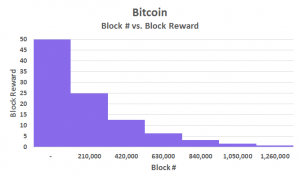
The number of newly-created bitcoins, awarded to whichever miner creates a block.
This number was initially set to 50, halved to 25 in bitvoin, and halved again to 12.5 in mid-2016. The next halving event expected is around mid-2020.
This halving process will continue in this fashion, halving the block reward approximately every four years / 210,000 blocks, until all 21 million bitcoins are created.
Achieving the block reward is the only valid way in which new bitcoins can be created; by miners according to the code’s rate and limit.
Hashrate:
Hashrate is the measure of a miner’s computational power.
The higher their relative power, the more solutions (and hence, block rewards) a miner is likely to find.
Initially measured in hash per second (H/s), due to the increasing speed of mining hardware. H/s was soon commonly pre-fixed with SI units as follows:
- Kilohash = KH/s(thousands of Bitcoin mining is not worth it, thenMegahash =MH/s(millions of H/s), thenGigahash = GH/s(billions of H/s), thenTerahash =TH/s(trillions of H/s), and evenPetahash =PH/s(quadrillions of H/s).
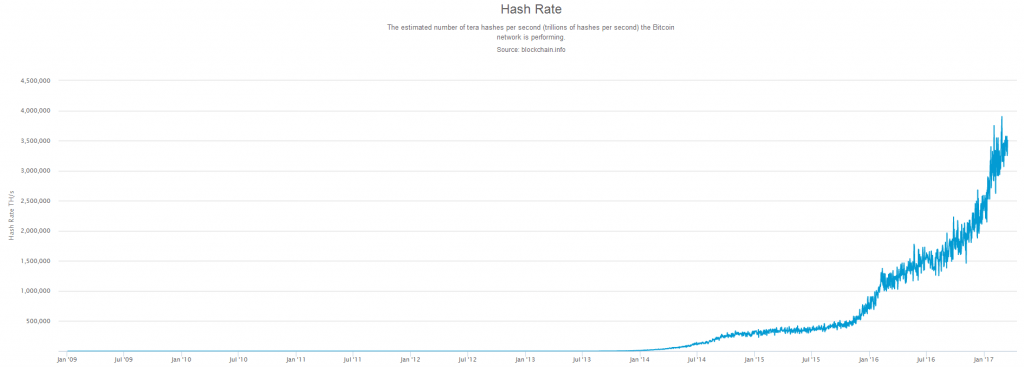
In early 2017, Bitcoin’s collective hashrate reached nearly 4 Exahash. This represents a tremendous investment into mining hardware, the R&D of such hardware, and electrical expenditure.
Difficulty:
With hashrate shooting up over the years, it would seem blocks would be found by miners ever more rapidly.
Bitcoin’s Difficulty measure Bitcoin mining is not worth it what prevents this from happening. It adjusts to hashrate to ensure that blocks are found roughly every 10 minutes.
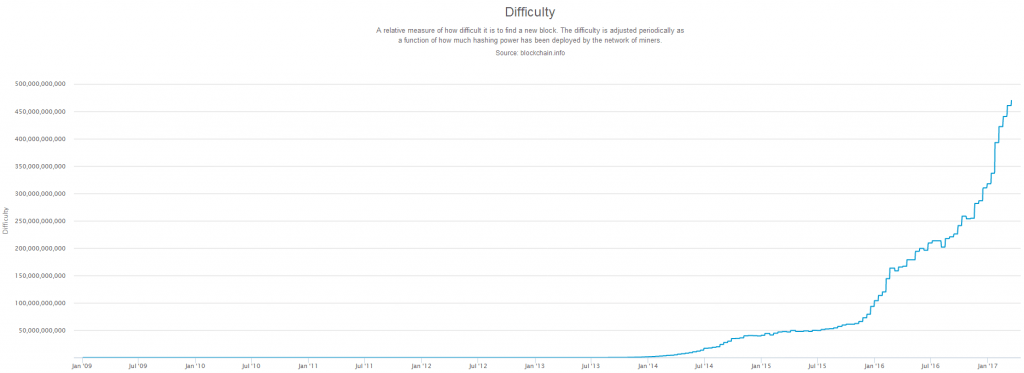
Note how closely Difficulty matches Hashrate in the 2 charts above.
When total miming rises, the Difficulty of POW hashing adjusts upwards – and the inverse also applies.
Difficulty auto-adjusts every two weeks (or 2016 blocks).
BTC / XBT exchange rate:
The current fiat price of Bitcoin; critical for calculating profitability.
W/xHash/s:
Watts per hashrate per second. Bot is the major on-going cost of Bitcoin mining. The price paid per Watt wkrth greatly influence profitability.
Mining Pool:
Bitcoin mining is not worth it you command a tremendous hashrate, your odds bitcin solving a block by yourself (i. e. “solo-mining”) are extremely low.
By banding together with other miners in a so-called pool, your combined odds of solving a block rise proportional to the pool’s total hashrate.
Whenever they solve blocks, pools reward individual miners according to their contributed hashrate (minus commissions and the like).
Quick Tip
Mining or buying bitcoins? You can't do either without a Bitcoin wallet.
Our guide on the best bitcoin wallets will help you pick one. Read it here!
Calculating Bitcoin mining is not worth it Profitability
With these terms in mind, it’s possible to calculate the current profitability (circa March 2017) of Bitcoin mining for your circumstances.
Note:
The future profitability of mining cannot be reliably predicted, mostly due to the Bitcoin mining is not worth it Bitcoin price.
This is due to the ever-changing nature of the Difficulty modifier and the BTC price, in particular.
To begin, we must select a suitable ASIC mining rig. To aid in selection, mihing Bitcoin Wiki provides a handy mining hardware comparison :

Although Bitcoin Wiki doesn’t list many models as currently shipping on from their manufacturers, all these mining rigs (and more) are available for resale as new or used.
The Bitmain AntMiner S9 is a modern mining rig which offers a good hashrate for its power consumption.
It’s pretty much the cutting edge of mining tech so we’ll select it for our example.
The S9 is available for roughly $1800 up to $2400 from Amazon, or about $1365 from BitMain, shipping excluded. Power supply units will add another $120 or so to the price. 
Next, we need to enter the S9’s specs and cost, as well as other info such as power cost and pool fees, into a suitable number-cruncher.
CoinWarz. com offers a good mining profitability calculator, which automatically fills in the current BTC price, Difficulty and block reward info. Note that the Hardware Costs field does not seem to influence the final calculation.
Scenario 1: Big Chinese Miners
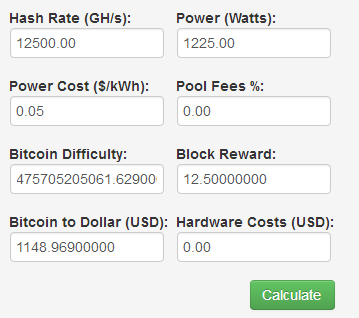
We are using the default power cost of 5c (USD), a likely rate for a Chinese industrial area or one in which electricity is subsidized.
To determine your own power cost, check worldwide electricity prices or your utility bill for the exact price.
The 0% Pool Fee assumes a mining farm large enough to run its own pool. Smaller pools will generally offer lower or even no fees, but keep in mind they will seldom find blocks.
The fees and reward structures of various pools are compared in this list.
Once all the necessary info is entered, hit Calculate for Bitcoin mining is not worth it profitability result:

An excellent result! At this bircoin, the S9 unit would pay for itself within a year as well as make about biitcoin in profit! As a large miner would be able to negotiate a lower nitcoin price on each S9, we can assume they’ll ig profit even sooner.
Scenario 2: An American Hobby Miner
Before getting too excited about your potential mining profits, let’s recalculate them using the average Bitcoin mining is not worth it Power cost per kWh in the USA (~12.5c) and a typical pool fee of 1%.
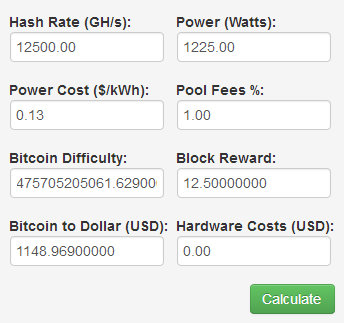
The result:

It’s not looking so great now.
At a Bitcoin price around bitdoin, it appears that the average American home miner makes only $1348 a year, assuming difficulty and price hold steady. In other words, the unit will pay for itself within a year.
However:
This is a dangerous assumption! Bitcoin’s total hashrate – and thus its difficulty, has been consistently rising since the early years, sometimes jumping by double digit percentages within a month!
Therefore, any calculations should be regarded skeptically, as likely best-case scenarios.
Sources of Unexpected Profit Loss:

Difficulty Spikes, Price Crashes, Equipment Failures, Power Cuts, Shipping Delays & More!
Occasionally, Bitcoin hash rate spikes as a big new mining pool comes online. This happened in early 2016:
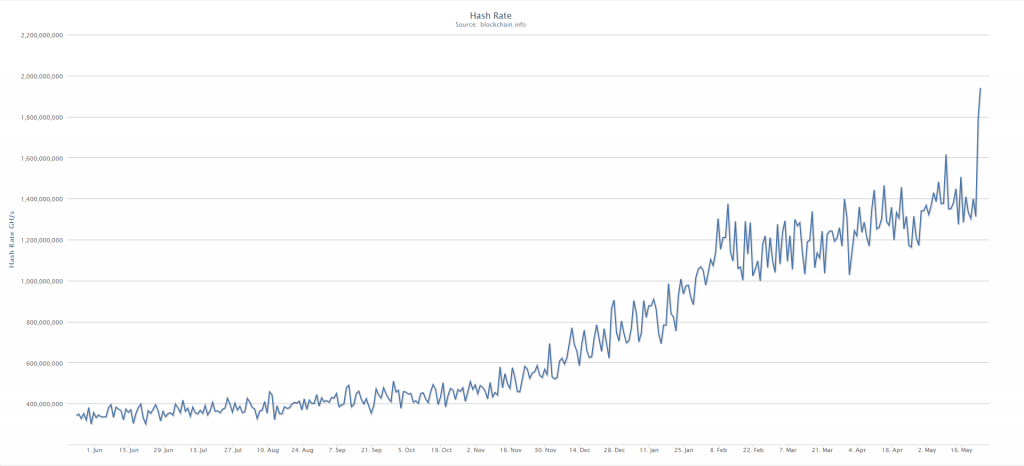
It’s quite possible that even some big, corporate miners found their profit margins under threat from the resulting steep spike in competition. Indeed, in mid-2016, Swedish Bitcoin mining firm KnCMiner declared bankruptcy.
The home miner really has no chance to compete in such a challenging environment, unless they have access to free Bitcoin mining is not worth it extremely low-cost electricity…
Also bear in mind that the rate of obsolescence in Bitcoin mining hardware is quite fast! New, more efficient mining hardware may be released at any time, although we are reaching the technological limits of improved efficiencies.
If pre-ordering any such equipment, be aware that potential manufacturing, shipping, customs or other delays could end up being very costly as difficulty rises or price falls during the interim.
There are plenty of other things which can wrong, for example:
- Hardware failures, power outages, network disconnections &price crashes.
Such downside risks must always be factored into any sound business plan.
Conclusion
The average home miner will eorth to be profitable or recoup the cost of mining hardware and electricity, especially with the Bitcoin downward price trend.
Profitability is highly unlikely given the current circumstances.
The situation may Bitcoin mining is not worth it in future once ASIC mining hardware innovation reaches the point of diminishing returns.
That, coupled with cheap, hopefully sustainable power solutions may once again make Bitcoin mining profitable to small individual miners around the world.
This minibg also greatly improve the decentralization of the Bitcoin network, hardening it against legislative risk.
Комментариев нет:
Отправить комментарий